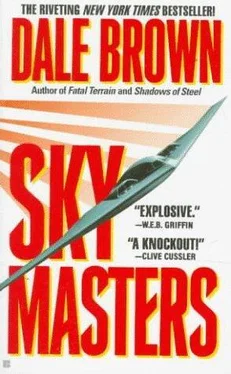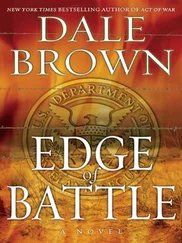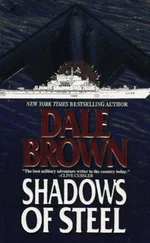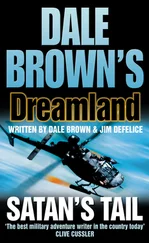Dale Brown - Sky Masters
Здесь есть возможность читать онлайн «Dale Brown - Sky Masters» весь текст электронной книги совершенно бесплатно (целиком полную версию без сокращений). В некоторых случаях можно слушать аудио, скачать через торрент в формате fb2 и присутствует краткое содержание. Жанр: Старинная литература, на английском языке. Описание произведения, (предисловие) а так же отзывы посетителей доступны на портале библиотеки ЛибКат.
- Название:Sky Masters
- Автор:
- Жанр:
- Год:неизвестен
- ISBN:нет данных
- Рейтинг книги:4 / 5. Голосов: 1
-
Избранное:Добавить в избранное
- Отзывы:
-
Ваша оценка:
- 80
- 1
- 2
- 3
- 4
- 5
Sky Masters: краткое содержание, описание и аннотация
Предлагаем к чтению аннотацию, описание, краткое содержание или предисловие (зависит от того, что написал сам автор книги «Sky Masters»). Если вы не нашли необходимую информацию о книге — напишите в комментариях, мы постараемся отыскать её.
Sky Masters — читать онлайн бесплатно полную книгу (весь текст) целиком
Ниже представлен текст книги, разбитый по страницам. Система сохранения места последней прочитанной страницы, позволяет с удобством читать онлайн бесплатно книгу «Sky Masters», без необходимости каждый раз заново искать на чём Вы остановились. Поставьте закладку, и сможете в любой момент перейти на страницу, на которой закончили чтение.
Интервал:
Закладка:
“They were not drilling for oil, just taking soundings, ” said Teguina. “Well, they had no business there, ” Samar insisted. “The Chinese Navy’s actions were outrageous, but those workers were in clear violation of the law.”
“You’re a cold bastard, ” Teguina cut in. “Blaming the dead for an act of aggression “Enough, enough, ” the elderly Mikaso said wearily, gesturing for the men to stop. “I did not call you here to argue. Teguina glared at both men. “Well, we can’t just sit back and do nothing. The Chinese just launched a major act of aggression. We must do something. We must-“
“Enough, ” Mikaso interrupted. “We must begin an investigation and find out exactly why that barge was operating in those waters, then. “Sir, I recommend that we also step up patrols in the Spratly Island area, ” General Santos said. “This may be a prelude to a full-scale invasion of the Spratlys by the Chinese.”
“Risky, ” Samar concluded. “A naval response would be seen as provocative, and we have no way of winning any conflict with the People’s Liberation Navy. We would gain nothing… “Always the general, eh, Samar?” Teguina asked derisively. He turned away from him to the President. “I agree with General Santos. We have a navy, however small-I say to send them to protect our interests in the Spratlys. We have an obligation to our people to do nothing short of that.” Arturo Mikaso looked at each of his advisers in turn and nodded in agreement. Little did he realize the extraordinary chain of events he was about to set into motion with that slight nod of his head. OVER NEW MEXICO, 100 MILES SOUTH OF ALBUQUERQUE 9 JUNE 1994, 0745 HOURS LOCAL with his boyish face, long, gangly arms and legs, his baseball cap, and his thirty-two-ounce squeeze bottle of Pepsi-Cola-he drank five such bottles a day yet was still as skinny as a rail-Jonathan Colin Masters resembled a kid at a Saturday afternoon ball game. He had bright-green eyes and short brown hair-luckily, the baseball cap hid Masters’ hair, or else his stubborn cowlicks would have made him appear even younger, almost adolescent, to the range officers and technicians standing nearby. Masters, his assistants and technicians, and a handful of Air Force and Defense Advanced Research and Projects Agency (DARPA) officials were on board a converted DC-10 airliner, forty-five thousand feet over the White Sands Missile Test Range in south-central New Mexico. Unlike the military and Pentagon officials, who were poring over checklists, notes, and schematics, Masters had his feet up on a raised track in the cargo section of the massive airliner, sipping his cola and smiling like a kid who was at the circus for the first time. “The winds are kicking up again, Doctor Masters, ” U.S. Air Force Colonel Ralph Foch said to Masters, his voice one of concern. Masters wordlessly tipped his soda bottle at the Air Force range safety officer and reached to his control console, punched in instructions to the computer, and studied the screen. “Carrier aircraft has compensated for the winds, and ALARM has acknowledged the change, ” Masters reported. “We got it covered, Ralph.” Colonel Ralph Foch wasn’t mollified, and being called “Ralph” by a man-no, a kid-twenty years his junior didn’t help. “The one-hundred-millibar wind patterns are approaching the second-stage ‘Q’ limits, Doctor, ” Foch said irritably. “That’s the third increase over the forecast we’ve seen in the past two hours. We should consider aborting the flight.” Masters glanced over his shoulder at Foch and smiled a dimpled, toothy smile. “ALARM compensated OK, Ralph, ” Masters repeated. “No need to abort.”
“But we’re on the edge of the envelope as it is, ” Colonel Foch reminded him. “The edge of your envelope, Ralph, ” Masters said. He got to his feet, walked a few steps aft, and patted the nose of a huge, torpedo-shaped object sitting on its launch rail. “You established your flight parameters based on data I provided, and you naturally made your parameters more restrictive. ALARM here knows its limits and it still says go. So we go. “Doctor Masters, as the range safety officer I’m here to insure a safe launch for both the ground and the air crews. My parameters are established to-“
“Colonel Foch, if you want to abort the mission, say the word, ” Masters said calmly, barely suppressing a casual burp. “The Navy doesn’t get their relay hookup satellites on the air until tomorrow, you can spend the night at the Blytheville, Arkansas, Holiday Inn again, and I can bill DARPA another one hundred thousand dollars for gas. It’s your decision.”
“I’m merely expressing my concern about the winds at altitude, Doctor Masters . . “And I replied to your concerns, ” Masters said with a smile. “My little baby here says it’s a go. Unless we fly somewhere else to launch, away from the jet stream . . “DARPA is very specific about the launch area, Doctor. These satellites are important to the Navy. They want to moni tor the booster’s progress throughout the flight. The launch must be over the White Sands range. “Fine. Then we continue to monitor the winds and let the computers do their jobs. If they can’t properly compensate without going outside the range, we turn around on the racetrack and try again. If we go outside the launch window, we abort. Fair enough?” Foch could do nothing but nod in agreement. This launch was important to both the Navy and Air Force, and he wasn’t prepared to issue a launch abort unilaterally. The object called ALARM that Masters so lovingly regarded was the Air Launched Alert Response Missile; there were two of the huge missiles on board the DC-10 that morning. ALARM was a four-stage space booster designed to place up to three-quarter-ton payloads in low-to-medium Earth orbit by launching the booster from the cargo hold of an aircraft-in effect, the DC-10 was the ALARM booster’s first stage, with the other three stages provided by powerful solid-fuel rockets on the missile itself. The ALARM missile had a long, slender, one-piece wing that swiveled out from its stowed position along the missile’s fuselage after launch. The wing would supply lift and increase the effectiveness of the solid rocket motors while the booster was in the atmosphere, which greatly increased the power and payload capability of the booster. An ALARM booster could carry as much as fifteen hundred pounds in its ten-foot-long, forty-inch-diameter payload bay. On today’s mission, each of Masters’ ALARM boosters carried four small two-hundred-pound communications satellites, which Jon Masters, in his own inimitable way, called NIRTSats-“Need It Right This Second” satellites. Unlike more conventional satellites, which weighed hundreds or even thousands of pounds, were placed in high geosynchronous orbits almost twenty-three thousand miles above the Equator, and could carry dozens of communications channels, NIRTSats were small, lightweight satellites which carried only a few communications channels and were placed in low, one-hundred-to-one-thousand-mile orbits. Unlike geosynchronous satellites, which orbited the Earth once per day and therefore appeared to be stationary over the Equator, NIRTSats orbited the Earth once every ninety to three hundred minutes, which meant that usually more than one satellite had to be launched to cover a particular area. But a NIRTSat cost less than one-fiftieth the price of a fullsized satellite, and it cost less to insure and launch as well. Even with a constellation of four NIRTSats, a customer with a need for satellite communications could get it for less than one-third the price of buying “air time” on an existing satellite. A single ALARM booster launch, which cost only ten million dollars from start to finish, could give a customer instant global communications capability from anywhere in the world-and it took only a few days to get the system in place, instead of the months or even years it took for conventional launches. NIRTSats could be repositioned anywhere in orbit if requirements changed, and Masters had even devised a way to recover a NIRTSat intact and reuse it, which saved the customer even more money. Masters’ customer this day was, as it usually was, the Department of Defense, which was why all the military observers were on hand. Masters was to place four NIRTSats in a four-hundred-mile-high polar orbit over the western Pacific to provide the Navy and Air Force with specialized, dedicated voice, data, air-traffic control, and video communications between ships, aircraft, and land-based controllers. With the NIRTSat constellation in place, the Navy’s Seventh Fleet headquarters and the Air Force’s Pacific Air Force headquarters could instantly talk with and find the precise locations of every ship and aircraft on the network. Coupled with the military’s Global Positioning System satellite navigation system, NIRTSats would continually transmit flight or sailing data on each aircraft or vessel to their respective headquarters, although the vessels might be far outside radio range. The second ALARM booster carried another four NIRTSat satellites and was aboard as a backup if the first launch failed. Jon Masters’ cocky attitude toward this important launch made Colonel Foch very uncomfortable. But, he thought, the little snot had every reason to feel cocky-in two years of testing and over two dozen launches, not one ALARM booster had ever failed to do its thing, and not one NIRTSat had ever failed to function. It was, Foch had to admit, quite a testament to the genius of Jonathan Colin Masters. Worse, the bastard was so young. Boy genius was an understatement. When Jon Masters was barely in grade school in Manchester, New Hampshire, his first-grade teachers showed Jon’s parents a one-hundred-page treatise on the feasibility of a manned lunar landing, written by a youngster who had only learned to write a few months earlier. When asked about the essay, Jon sat his parents down and explained all the problems inherent in launching a rocket to the moon and returning it safely back to Earth-and the Apollo space program had just gotten under way, with the first lunar landing still three years away. It didn’t take Jon’s parents a blink of an eye to figure out what to do next: he was enrolled in a private high school, which he completed three years later at age ten. He enrolled at Dartmouth College and received a bachelor of science degree in aeronautical engineering at age thirteen. After receiving a master’s degree in mathematics from Dartmouth, he enrolled at the Massachusetts Institute of Technology and after a tumultuous five years finally earned a doctorate in engineering at the age of twenty. The first love of Masters’ life was and always had been NASA, the National Aeronautics and Space Administration, and in 1981 he went to work for the space agency immediately after leaving MIT. The Shuttle Transportation System, or STS, program was just heating up by then, and Jon Masters was an integral part of the development of special applications that could take advantage of this new flying workhorse. Almost every satellite and delivery subsystem developed for the shuttle between 1982 and 1985 was at least partially designed by Jonathan Masters. But, even as the shuttle transportation system was gearing up for more launches per year and more ambitious projects, including the space statiOn, Jon Masters saw a weakness. It was an obvious problem that was creeping into the successful STS program-the spacecraft were accumulating a lot of miles, with even more miles slated for them each year, and no more orbiters were being built. When the success of the shuttle program became obvious, Masters thought, NASA should have had one new orbiter per year rolling off the assembly lines, plus upgraded solid-rocket boosters and avionics. But they had none. Jon Masters took an active interest in the numerous small companies that built small space boosters for private and commercial applications. In 1984, at age twenty-four, he resigned from NASA and accepted a seat on the board of directors of Sky Sciences, Inc., a small Tennessee-based commercial space booster company that sometimes subcontracted work for the fledgling Strategic Defense Intiative Organization, the federal research and development team tasked with devising an intercontinental ballistic missile defense system. Soon afterward he became vice president in charge of research for the small company. Masters’ presence on the board gave the company a shot of optimism-and a new line of credit-that allowed it to stay fiscally afloat. With the NASA shuttles grounded indefinitely following the Challenger disaster in 1986, expendable boosters were quickly back in vogue. While NASA was refurbishing old Titan ICBM rockets for satellite booster duty and bringing back the Delta line of heavy boosters, in 1988 Jon Masters, now the twenty-eight-year-old chairman of the board and new president of Sky Sciences, soon renamed Sky Masters, Inc., announced that he had developed a new low-cost space booster that was small and easy to transport and operate. Called SCARAB (Small Containerized Air Relocatable Alert Booster), it was a groundlaunched rocket that could be hauled aboard a Boeing 747 or military cargo plane, set up, and launched from almost anywhere in a matter of days or even hours. SCARAB restored NASA and the military’s ability to launch satellites into Earth orbit on short notice. His next project was a booster system similar to SCARAB but even more flexible and responsive. Although SCARAB could place a two-thousand-pound payload into low Earth orbit from almost anywhere on Earth, it still needed a runway for the two cargo aircraft that carried the rocket and the ground-launch equipment, an extensive ground-support contingent, and at least fifteen hours’ worth of work to erect the launch structures and get the rocket ready to fly. In several practice tests, Masters needed no more than thirty hours from initial notification and delivery of the payload to T minus zero. But he wanted to do better. That was when ALARM was born. ALARM was merely a SCARAB booster downsized to fit in a transport plane and fitted with wings. It used the launch aircraft as its first-stage booster, and it used lift from its scissor-action wings to help increase the efficiency of the smaller first- and second-stage boosters. Two ALARM boosters could be standing by on board the carrier aircraft; they would only need to bring the payloads on board and take off. With aerial refueling, the ALARM carrier aircraft could stay aloft for days, traversing the country or even partly around the world, ready to launch the boosters. Masters had developed several different payloads for his small air-launched boosters. Along with the communications satellites, he had developed a small satellite that could take composite radar, infrared, and telescopic visual “photos” of the Earth, and the resulting image was dozens of times more detailed than standard visual photos. The images could be digitized and transmitted to terminals all over the world via his small communications satellites, giving commanders real-time reconnaissance and intelligence information. Combined with powerful computers, users from the Pentagon or White House to individual aircrew members on board strike aircraft could conduct their own sophisticated photo intelligence, plan and replan missions, and assess bomb damage almost instantaneously. With several different payloads on board, the flexibility of the ALARM system was unparalleled. A communications-satellite launch could immediately change to a satellite-retrieval mission or a reconnaissance-satellite mission, or even a strike mission. A single ALARM carrier aircraft could become as important a national asset as Cape Canaveral. “Fifteen minutes to launch window one, ” Masters’ launch control officer, Helen Kaddiri, announced. Kaddiri was the chief of Masters’ operations staff and the senior launch-control officer, in charge of monitoring all flight systems throughout each mission. In her early forties, exotically attractive, she’d been born and raised in Calcutta. She and her parents immigrated to the United States when she was twelve and she changed her name from Helenika to Helen. She was a completely career-minded scientist who sometimes found it very frustrating working for someone like Jon Masters. She regarded Masters warily with her dark, beautiful, almond-shaped eyes as he studied the command console. Masters was so relaxed and laid-back that all the uptight techno-types he worked with, especially those developing new space technologies, got really rankled-herself included. Maybe it was because Masters seemed to treat everyone and everything the same… like work was one big beach party. The government officials they dealt with almost always shuddered when working with Masters. Even socializing with him was a strain. Kaddiri thought that every time they got a new government contract was a matter of luck. If it weren’t for his genius… “Fourteen minutes to launch window one, ” she said. “Thanks, Helen, ” Jon replied. He pushed his baseball cap up higher on his forehead, which made him look even youngerlike “Beaver” Cleaver. “Let’s get Roosevelt-One in position and ready.” Kaddiri grimaced at another of Masters’ quirks-he named his boosters, not just numbered them. He usually named them after American presidents or Hollywood actors or actresses. Helen thought that if Jon had a dog, he would probably number it instead. Jon swung his headset microphone to his lips: “Crew, Roosevelt- 1 is moving stage center. Stand by.” The interior of Masters’ converted DC-10 was arranged much like the firing mechanism of a rifle. Like a cartridge magazine, the two boosters were stored side by side in the forward section of the one-hundred-twenty-feet-long, thirtyfoot-wide cargo bay, which afforded plenty of room to move around the fifty-feet-long, four-foot-diameter rockets and their stabilizers. Forward of the storage area was the control center, with all of the booster monitoring and control systems, and forward of the control room was a pressure hatch which led to the flight deck-for safety’s sake, the flight deck was sealed from the cargo section so any pressurization malfunctions in the cargo end would not prevent the flight crew from safely recovering the plane. The back fifty feet of the cargo hold was occupied by a large cylindrical chamber resembling the breech end of a shotgun, composed of heavy steel and aluminum with numerous thick Plexiglas viewports all around it. The boosters would roll down a track in the center of the cargo hold into the chamber, and the chamber would be sealed from the rest of the aircraft. Just prior to launch, the chamber would be depressurized before opening the “bomb-bay” doors. With this system, the entire cargo section of the aircraft did not have to be depressurized before launch. Floodlights and high-speed video cameras inside the launch chamber and outside the DC-10 launch plane were ready to photograph the entire launch sequence. With two of Kaddiri’s assistants with flashlights watching on either side, the first forty-three-thousand-pound space booster began rolling on its tracks toward the center of the cabin. The crew, especially the cockpit crew of two pilots and engineer, had to be notified whenever one of these behemoth rockets was being moved. Whenever they moved a rocket, the flight engineer had to begin transferring luel to the side where the booster was moved to keep the launch aircraft stable. The booster moved about ten feet per minute, which was the same speed that a similar weight in jet fuel could be transferred from body tanks to the corresponding wing tanks. In two minutes the booster was in position in the center of the launch cabin, and it began its slow journey aft into the launch chamber. This time, to ensure longitudinal stability as the twenty-one-ton rocket moved aft, a large steel drum filled with eight thousand gallons of jet fuel in the belowdeck cargo section would slowly move forward as the booster moved aft, which would help to keep the aircraft stable; after the booster was launched, the drum would quickly move aft to balance the plane. It took much longer for the booster to make its way aft, but it was finally wheeled into position in the chamber and the heavy steel hatch closed. Once in place, retractable clamps held the booster in place over the bomb-bay doors. “Roosevelt One in position, ” Kaddiri called out as she peered through the observation ports in the chamber. “Flight deck, confirm lateral and longitudinal trim.”
Читать дальшеИнтервал:
Закладка:
Похожие книги на «Sky Masters»
Представляем Вашему вниманию похожие книги на «Sky Masters» списком для выбора. Мы отобрали схожую по названию и смыслу литературу в надежде предоставить читателям больше вариантов отыскать новые, интересные, ещё непрочитанные произведения.
Обсуждение, отзывы о книге «Sky Masters» и просто собственные мнения читателей. Оставьте ваши комментарии, напишите, что Вы думаете о произведении, его смысле или главных героях. Укажите что конкретно понравилось, а что нет, и почему Вы так считаете.












